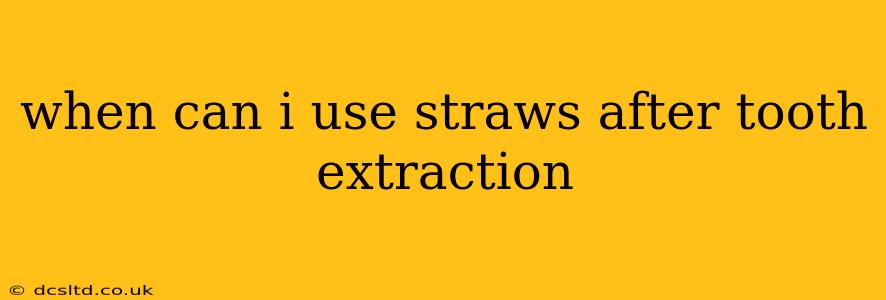When Can I Use Straws After Tooth Extraction?
The simple answer is: avoid using straws for at least a week, and possibly longer, after a tooth extraction. Using a straw after tooth extraction can significantly hinder the healing process and increase the risk of complications. This post will delve deeper into why, explaining the risks and providing helpful tips for post-extraction care.
Why Should I Avoid Straws After Tooth Extraction?
The act of sucking through a straw creates significant suction in your mouth. This suction can dislodge the blood clot that forms in the extraction site – a crucial part of the healing process. This blood clot, also known as a fibrin clot, acts as a protective barrier, preventing infection and promoting proper healing. Dislodging it leads to a condition called dry socket, a painful and potentially serious complication.
What is Dry Socket (Alveolar Osteitis)?
Dry socket is a painful condition that occurs when the blood clot is lost or dislodged from the extraction site. This exposes the underlying bone and nerve endings, causing intense throbbing pain, often radiating to the ear and jaw. Dry socket can significantly delay healing and may require professional treatment.
How Long Should I Avoid Straws After a Tooth Extraction?
While a general guideline is to avoid straws for at least one week, your dentist's specific post-operative instructions should always be followed. The healing time varies depending on the complexity of the extraction and your individual healing capacity. Some extractions may require longer periods of avoiding straws and other forms of suction.
What Other Activities Should I Avoid After Tooth Extraction?
Besides straws, you should also avoid:
- Smoking: Smoking significantly increases the risk of dry socket and impedes healing. Nicotine restricts blood flow to the extraction site.
- Spitting: Like straws, spitting creates suction that can dislodge the blood clot.
- Drinking through a very thick milkshake: Even thicker fluids can create some suction
- Using a mouthwash (unless prescribed by your dentist): Many mouthwashes contain alcohol, which can irritate the extraction site.
- Vigorous rinsing: Gentle rinsing with salt water is generally recommended, but forceful rinsing should be avoided.
What Can I Drink After a Tooth Extraction?
Stick to fluids that you can sip gently without creating suction. Good options include:
- Water: Essential for hydration and cleaning the mouth.
- Broth: Provides nutrients and hydration.
- Smoothies (thin consistency): Ensure they are thin enough to avoid suction.
- Applesauce (thin consistency): Avoid anything with bits that might get lodged in the socket.
When Can I Resume Normal Eating After Tooth Extraction?
You'll likely be able to resume a normal diet gradually after a few days, but this also depends on the specific extraction. Start with soft foods and gradually incorporate firmer foods as the healing progresses. Always follow your dentist's advice.
What Should I Do If I Suspect Dry Socket?
If you experience severe pain, throbbing, a bad taste in your mouth, or visible bone in the extraction site, contact your dentist immediately. These are all potential signs of dry socket and require prompt attention.
This information is for general knowledge and should not be considered medical advice. Always follow your dentist's specific post-operative instructions after a tooth extraction. If you have any concerns or questions, contact your dentist or oral surgeon.
